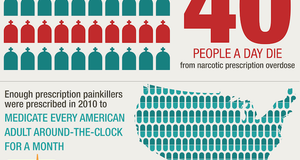Perpetuating the Cycle: Opioid Addiction and the Criminal Justice System
By
2016, Vol. 8 No. 07 | pg. 1/2 | »
IN THIS ARTICLE
KEYWORDS
AbstractHeroin use and the consequences that come from it are skyrocketing around the United States. From major metropolitan areas to rural towns, millions of people are in the throes of opiate addiction. The traditional response to the illegal use and possession of drugs, including opiates, in the United States is incarceration, but this response is wholly inadequate to address the issue of heroin addiction and may actually contribute to the problem by placing users in situations that promote opiate use. Several treatment options for opiate addiction have been found to be far more successful than traditional punitive punishment in reducing recidivism and the crime that has been well-documented as associated with heroin use. The government should follow the example of some other nations using the forced detoxification that is imprisonment to rehabilitate opiate users and thereby decrease heroin dependency and associated crime rates. A fourteen year old kid, who will be called “Billy,” came from a good home in Michigan and was very successful in school. Billy started experimenting with prescription drugs like Vicodin and Adderall and he found that he particularly liked the painkillers like Vicodin. Billy stated he liked it because “it kind of numbed everything” even though Billy could not identify any particular thing or pain in his life that he was trying to numb (Waterman, 2015, para. 19). Now Billy is addicted to heroin, he dropped out of school, and suffers from profuse sweating and shaking limbs when he does not have a dose of heroin in his body. Besides wearing long sleeved shirts every day to hide his track marks and abscesses, Billy has been in and out of prison and has even overdosed (Waterman, 2015). Unfortunately Billy’s story is not an isolated case: there is an “epidemic” of heroin and opioid addiction sweeping across the United States (Gonzalez, 2016). Since the beginning of the “war on drugs” the United States has imprisoned an enormous number of drug addicts yet there has been little, if any, evidence that the war on drugs has made any substantial impact on the drug problem in this country. There is a well-documented link between drug use and crime, and drug users have consistently been found to participate in riskier behavior (Saadatmand, Toma, & Choquette, 2012; Grogger & Willis, 2000; Gordon et al., 2013). The vast majority of traditional criminal justice policies and the sentences handed down to drug users have done nothing to slow the drug problem.The opiate problem in the United States is a legitimate problem that has negative individual and societal effects. Crime, violence, health problems, and economic strain are all societal problems somehow influenced by opiate users. The traditional means of dealing with opiate users by way of jail time and prison sentences has a terrible record with few stories of success because it is not capable of treating offenders or remedying the societal costs of drug use. Evaluation of treatment programs and drug courts shows that a shift away from punitive-based criminal justice actions against opiate users will not only increase the chance of successful addiction treatment but also lessen the strain on society. The Societal Cost of OpiatesAll drugs, legal or illegal, have costs associated with their use and abuse. Alcohol is a perfect example of a legal drug that is frequently abused and still causes societal harm. Alcohol is legal with certain requirements such as a minimum age for use, not drinking while operating a vehicle, and in some places not drinking in public. The heroin epidemic that society is currently experiencing got a big jump start from the abuse of the overprescribing of legal opiate pain medication (Hayes & Brown, 2012). Many people in the United States start using prescription pain medications like Oxycodone and eventually start using heroin because heroin is a cheaper alternative to the same high (Waterman, 2015; Cicero, Ellis, Surratt, & Kurtz, 2014). Opiates pose a personal health risk to anyone who uses the drug even once and additional risks to people who are frequent users or addicts. For example, one of the risks that makes opiates so dangerous is the high risk of overdose that can occur after the very first use (Kuhn, Swartzwelder, & Wilson, 2014). Opiates cause relaxation and slow the respiratory rate so much so that overdose usually results in the cessation of breathing (Kuhn et al., 2014). The death of a user and the emotional cost on families and friends that lose someone to a heroin overdose needs to be included in the overall societal costs of opiate use. Opiate overdose is a major threat to anyone who chooses to use them and the frequency of overdoses is shocking. One study of approximately 1,000 heroin users found that about 73 percent of them had witnessed at least one overdose and 14 percent of them had witnessed an overdose resulting in death (Davidson et al., 2002). Besides the risk of overdose there are other serious health risks associated with opiate use, especially injectable heroin usage. Studies have found that heroin addicts are more likely to engage in unprotected sex with others, often in exchange for heroin, and many addicts also share needles which substantially increases their risk of spreading HIV and hepatitis (Kuhn et al., 2014). The health risks associated with opiate use, and especially heroin use, include a very real risk of overdose resulting in death along with the risk of contracting life-altering health problems like HIV and hepatitis. In fact, a heroin user is 20 to 60 times more likely to die prematurely than a non-heroin user (Blom Nilsson, Lundgren, & Chassler, 2014). While these risks are substantial they are largely, but not entirely, private and individual. However, there are other costs that affect society as a whole. Since the inception of the “war on drugs” the number of people incarcerated in American prisons increased exponentially (Sevigny, Pollack, & Reuter, 2013). Imprisoning so many people for drug related crimes may have seemed like a good idea in an attempt to slow the negative effects of drug addiction and the drug trade, but eventually there needs to be an honest evaluation of these policies to see how they meet the desired goals. In analyzing the rampant incarceration of people for drug crimes a cost-benefit analysis should be conducted. States budget so much money for corrections and prisons that it is second only to the Medicaid budget, and those numbers do not even include the cost of correctional employee salaries, benefits, or inmate hospital care (Henrichson & Delaney, 2012). That budget amount is astronomical and spending that much money on a particular program is only acceptable if the results are meeting the desired goals of the program. The average annual cost of housing an inmate varies greatly from state to state but the numbers range from $14,000 to $60,000 (Henrichson & Delaney, 2012), a cost that demands that the government determine if incarceration is working. If the goals of incarcerating people for drug related crimes is to reduce drug crime recidivism, make safer communities, or reduce drug overdoses then incarceration is a miserable failure. More than 46,000 people died from drug overdoses in 2013 and places like Denver have seen a 600 percent increase in heroin overdoses in the last five years (Drug Enforcement Administration, 2015; CBS Denver, 2015). Heroin addicts have also consistently been found to participate in a higher proportion of criminal activity outside of the crimes specific to drug possession than other drug users, and typically the more an addict uses the more crime they commit (Gordon et al., 2013; Blom Nilsson et al., 2014; Hucklesby, 2010). The cause for this is likely multifaceted but is probably related to the strength of the addiction that causes the addicts to be motivated to do nearly anything to obtain their next dose and also heroin addict’s propensity for risky behavior. There are obvious costs of opiate use and addiction that negatively affect the health of addicts and the happiness of family and friends of addicts along with negative consequences for society that include a high cost of inmate incarceration, the risk of serious disease and illness, and the risk of crime that is associated with heroin use. Evaluating the traditional criminal justice system methods along with the treatment options for opiate addiction is necessary to determine the most effective method for achieving the goals of drug law. Criminal Justice System MethodsThere are primarily two ways that the traditional criminal justice system addresses drug crimes; the traditional judicial procedure consisting of hearings and trials, and also drug courts. The traditional jurisprudence system is concerned with enforcing the law and punishing those who break the law. Traditional law enforcement against drug offenses is not only motivated by a desire to affect change with regards to drug usage but also by a desire to decrease risky behavior often associated with drug users (Hucklesby, 2010). As explained above, drugs and drug users are often involved in crime that extends beyond the drug offense and the war on drugs created tough policies and sentences that often gave drug offenders longer prison sentences than before. It would be unfair to say that the traditional criminal justice methods in drug crimes does not value drug treatment or rehabilitation but that is definitely not the primary focus. The traditional court setting sees rehabilitation as one of many goals and not as the primary function (Hucklesby, 2010). In addition, traditional court settings often have a zero tolerance policy during any probation or drug treatment program when the offender relapses and is found to have used drugs during that time period. That policy that has come under scrutiny by proponents of drug treatment programs as ignoring the difficulty in quitting heroin in such an abrupt manner (Hucklesby, 2010). Drug treatment programs are different than the traditional judicial outcome because drug courts view rehabilitation as an intrinsic and primary goal (Hucklesby, 2010). Based on the differences between drug courts and traditional court it can be seen that traditional court still views its primary means to stop drug crime as deterrence. There is no other reason to extend prison sentences and take a tougher attitude on those convicted of drug crimes if the goal is not to deter future drug usage. The problem is that this goal has not ever been attained by the policies of the war on drugs and there is no reason to think that suddenly the same policies and sentences will start being successful. The drug court programs in the United States are relatively new but now enough research and literature examining their efficacy exists to make a judgment one way or another about their ability to achieve the goals of the justice system as they relate to drugs. Drug courts began in the 1980’s when studies began to show that drug treatment programs were effective even if the programs were not voluntary (Hucklesby, 2010). This means that the initial research on drug courts found that even when drug treatment was court ordered and not sought out by the drug offender there was still some benefit in the treatment. Some opponents of drug courts claim that the cost of drug treatment programs are too expensive and that there is too high of a drop-out or failure rate by the offenders (Hucklesby, 2010). Research shows that those concerns do not seem to be warranted. For example, some studies on the efficacy of drug courts find a 14 percent drop in drug offender recidivism compared to traditional court settings (Hucklesby, 2010). Seeing a 14 percent reduction in drug offender recidivism is a significant benefit especially if the cost is lower than typical incarceration costs. It is true that drug treatment programs can be expensive but compared to the average cost of typical incarceration drug treatment programs are more cost effective (Hucklesby, 2010). If there is more value in the drug court programs than in traditional court sentences and that value comes with double-digit reduction in offender recidivism then the case is strong for drug courts being better equipped to meet the goal of reducing crime and slowing drug addiction. Another common argument for typical incarceration is that people cannot use drugs while in prison and it can be seen as a kind of forced sobriety. Unfortunately there are several serious problems with the idea that locking offenders up keeps them away from the drug. The first problem is that there are plenty of drugs in prison and heroin users are much more likely to continue to use the drug in prison than cocaine or methamphetamine addicts (Strang et al., 2006). Studies also show consistently that up to 15 percent of all those incarcerated in the United States have an opioid addiction (Gordon et al., 2013; Mitchell et al., 2009). The bottom line of this debate is that the traditional court sentences see treatment as just one goal among many but there is debate about whether or not the traditional treatment programs are run effectively as to give the offender a chance to complete it successfully. Drug courts see rehabilitation and treatment as the primary goal of the justice system in a way that sees the addiction as the root cause of the problems. Finally, drugs exist in prisons and it is easy for the prisoners to continue their use while incarcerated so mere incarceration does not succeed like it should in preventing offenders from using drugs. There are other treatment options for opiate users besides incarceration that could potentially be paired with drug court programs for a better outcome in the fight against drug addiction.Continued on Next Page » Suggested Reading from Inquiries Journal
Inquiries Journal provides undergraduate and graduate students around the world a platform for the wide dissemination of academic work over a range of core disciplines. Representing the work of students from hundreds of institutions around the globe, Inquiries Journal's large database of academic articles is completely free. Learn more | Blog | Submit Latest in Criminology & Criminal Justice |
















